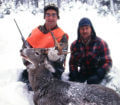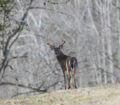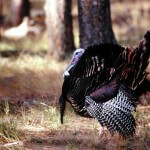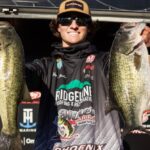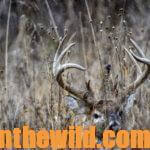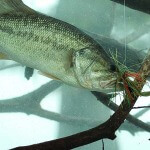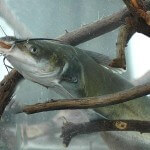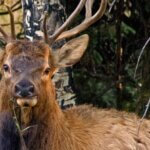John’s Note: When you’re hunting over fields, whether snow fields in Canada or agricultural fields in the South, the same equipment for accurate shooting is required. Only the temperature varies. With a flat-shooting rifle, a quality scope and a cartridge that consistently shoots 1- to 2-inch groups, you can shoot with confidence at ranges of more than 100 yards in pastures and croplands.
Well-known outdoorsman Tad Brown of Missouri has hunted pastures and croplands around his home for more than 30 years. He’s developed strategies that regularly produce bucks at distances of 100 yards or more in the fields and pastures in his area. Brown is the product development manager for Hunter’s Specialties (http://www.hunterspec.com/).
 “I like to hunt green pastures,” Brown explains. “One time I slipped up to the edge of a pasture where I’d seen deer previously. Using my binoculars, I spotted a group of deer at the other end of the field from me – about 180-200 yards away. Hunting with a .270 Remington rifle (https://www.remington.com), I picked up a nice-sized buck in my riflescope. I let the crosshairs settle behind the deer’s front shoulder and squeezed the trigger. The buck went down immediately when my 130-grain Sierra (http://www.sierrabullets.com) Boat Tail hollow point hit him. I’d tested many different bullets to determine which one shot best in my rifle. The hollow point gave me good expansion when it went through the ribs and did the damage required to dump the buck.”
“I like to hunt green pastures,” Brown explains. “One time I slipped up to the edge of a pasture where I’d seen deer previously. Using my binoculars, I spotted a group of deer at the other end of the field from me – about 180-200 yards away. Hunting with a .270 Remington rifle (https://www.remington.com), I picked up a nice-sized buck in my riflescope. I let the crosshairs settle behind the deer’s front shoulder and squeezed the trigger. The buck went down immediately when my 130-grain Sierra (http://www.sierrabullets.com) Boat Tail hollow point hit him. I’d tested many different bullets to determine which one shot best in my rifle. The hollow point gave me good expansion when it went through the ribs and did the damage required to dump the buck.”
Brown sights in his rifle dead-on at 200 yards. “By taking a long shot like this, the buck never saw, heard or smelled me,” Brown emphasizes. “The further you are away from the deer, the more likely you will be to bag him, if you can shoot accurately.”
At 100 yards, Brown’s rifle will hit 2-1/2 to 3-inches high. At 300 yards, the bullet will land 2-inches low. From 100 to 300 yards, Brown can hold dead-on and down a buck. With a deer at 400 yards, Brown settles his crosshairs on the deer’s back and makes a heart or a lung shot. Brown prefers European-style reticles in his scope, which are wide coming from the side of the scope and narrow toward the center of the scope where they cross, because they give him a finer aiming point. According to Brown, in his home state of Missouri, most hunters prefer a .30-30 or a .30-06 for deer hunting. The vast majority of the hunters hunt woodlots instead of fields, which means less hunting pressure exists around the edges of the fields than in the woodlots. Where you find less hunting pressure, you’ll usually locate more and bigger bucks. “When I hunted in timber, I would see numbers of deer, but I couldn’t get a shot off,” Brown mentions. “I’d either spot a white tail, a flash of antlers or a buck standing on the opposite side of a brush pile or a large tree. However, because of intense hunting pressure, I saw more bucks in the field and had the opportunity for a better shot than I ever had in the woods.”
 What Guns Are Best for Field Shooting:
What Guns Are Best for Field Shooting:
Although people often debate which calibers are best for long-distance shooting, Brown believes the .243, the 6mm, the .270 and the .225 are flat-shooting, low-recoil, easier-to-sight-in rifles than others on the market. “Always consider the recoil of the rifle when choosing a gun with which to hunt over croplands,” Brown emphasizes. “If the gun kicks so much that you anticipate the kick and flinch, you may pull your sights off the deer and miss. However, if you shoot a smaller-caliber rifle and know where the bullet will hit at distances from 100 to 300 yards, you won’t have to worry much about flinching.”
My personal favorite guns for hunting deer over croplands at long ranges are the Browning .243 (http://www.browning.com) and the Remington 6mm (https://www.remington.com). To see and bag more bucks this season, don’t fight the crowds in the woods. Move to the fields or pastures. Use these strategies. You can bet on cropland bucks.
 Brown also has discovered another advantage to field hunting. When he sits in a tree stand 15 to 20 feet off the ground and uses his binoculars and riflescope, he can see where the deer falls or which way the deer runs when he’s hit. Brown then finds the deer quickly and recovers the animal much more easily than when he hunts in the woods.
Brown also has discovered another advantage to field hunting. When he sits in a tree stand 15 to 20 feet off the ground and uses his binoculars and riflescope, he can see where the deer falls or which way the deer runs when he’s hit. Brown then finds the deer quickly and recovers the animal much more easily than when he hunts in the woods.
To get John E. Phillips’ eBooks and print books on hunting deer, including his newest deer-hunting book, “Whitetail Deer and the Hunters Who Take Big Bucks,” available at http://amzn.to/2bYwYOK/, click on these books to learn more, “How to Hunt and Take Big Buck Deer on Small Properties,” “How to Hunt Deer Up Close: With Bows, Rifles, Muzzleloaders and Crossbows,” “PhD Whitetails: How to Hunt and Take the Smartest Deer on Any Property,” “How to Take Monster Bucks,” “How to Hunt Deer Like a Pro,” and “Bowhunting Deer: Mossy Oak Pros Know Bucks and Bows,” or to prepare venison, “Deer & Fixings.” Or, go to www.amazon.com/kindle-ebooks, type in the name of the book, and download it to your Kindle, and/or download a Kindle app for your iPad, SmartPhone or computer. You also can find John’s books on Nook at www.barnesandnoble.com.
For free information on making jerky from your deer to provide a protein-rich snack, you can download a free book from https://johninthewild.com/free-books.

